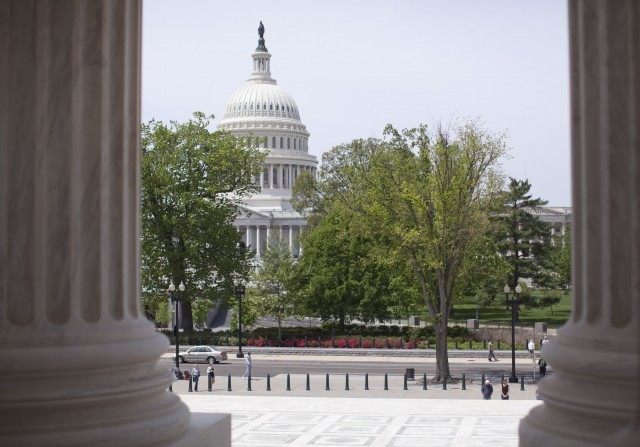I recently saw a great bumper sticker that read: “Official US Government Philosophy: If It Ain’t Broke, Fix It Until It Is.”
It was good for a chuckle about the failures of government. But it is a deadly serious matter for our future because we remain trapped in a dangerous paradox.
Consider the pressure Washington, D.C. has applied: Under the guise of making things better, it becomes involved in certain areas of our lives; the problems then become worse, so the government has to devise another solution to fix the problem that it created in the first place. It results in a neverending cycle of government intervention.
So let’s examine a few striking examples of how the federal government took an issue that was not broken and “fixed it” until it became shattered.
Consider the issue of welfare. Today we are spending an enormous amount of money on anti-poverty programs, in particular with the massive increases put in by Obama. Washington now spends more than $1 trillion a year on 80 different federal programs.
It all began when Lyndon Johnson declared war on poverty in 1964, more than half a century ago.
While most conservatives condemn the Great Society – LBJ’s massive program to combat poverty, illiteracy, and other ills in society – as a colossal failure, the Left defends it as a success. According to the Washington Post, “In 1964, the poverty rate was 19 percent. Ten years later, it was 11.2 percent, and it has not gone above 15.2 percent any year since then.” It then concluded, “Contrary to what you may have heard, the best evidence indicates that the War on Poverty made a real and lasting difference.”
The Post analysis, though, has two major problems: the authors failed to discuss the price tag of more than $22 trillion, and they did not take into account the increase in population, not to mention that such programs have trapped millions in a lifestyle of poverty, despair, and hopelessness.
In 1964, the US population was 192 million, and if we calculate the poverty rate of 19 percent, we find that 36.5 million lived in poverty. Today, the population is 326 million, so if we look at the latest poverty rate number, which was 13.5 percent in 2015, we find that 44 million Americans live in poverty.
How could this be measured a success?
Especially if you consider that in 1959 the poverty rate was 24 percent, so it had fallen to 19 percent by 1964 without a “war on poverty.”
Although there has been a minor decrease in the rate of poverty, the only result of Johnson’s “Great Society” was a massive redistribution of wealth from producers to non-producers, which was likely his real intent. Was it worth the more than $22 trillion income confiscated from the private sector — trillions that could have been used to increase consumption, add jobs, and promote a vibrant economic environment?
As to the issue of public education, we once boasted of the finest public school system in the world; now not so much. We have fallen way behind many modern nations and even a few third-world countries in critical subjects like math and science.
In international competition, American kids are slipping further and further down the scale. In 2013, the Program for International Student Assessment (PISA) tested American 15-year-old kids and ranked them 31st in math, 24th in science, and 21st in reading. In math and reading, America was beaten by Vietnam, a third world communist nation.
Although we may be outmatched, we are far from out-gunned, but that is also a major issue. We spend more per pupil on public education, nearly $13,000 per student per year than any nation on Earth, yet we are not reaping bountiful harvests in return.
A recent report revealed that six schools in Baltimore, Maryland — five high schools and one middle school — had not a single student that was proficient in math and English. That’s not only embarrassing; it’s heartbreaking.
How bad is it? The International Adult Literacy Survey (IALS) tested a cross-section of adults aged 16 to 65 and found that the oldest group, those 56-65, scored the highest, ranking second in the world. “For those attending school in the 1950s,” Paul E. Peterson of the Hoover Institute noted, “SAT scores reached an all-time high.”
Put simply, before Washington got involved, things were better.
But nothing speaks to government mismanagement like the healthcare crises. Costs were once reasonable. But enter federal programs and private insurance, and they have spiraled upward at nightmarish rates, far faster than wages and inflation. Like student loan programs and the rising cost of college, government involvement in health care and insurance has driven up prices. And with rising costs, we get increased government spending in a self-perpetuating, neverending cycle.
As a nation, spending on health care in 1960 was 5 percent of GDP; in 2015 it was nearly 18 percent. Today Medicare and Medicaid total more than $1.1 trillion, and they are increasing rapidly.
To correct the problem, the last thing we need is more government, like the recent Ryancare proposal. To fix this major issue, we need free market solutions, the only real answer to rising costs. Uncouple the government from healthcare and insurance markets, allow more competition, especially with purchasing health insurance, and prices will fall. Indeed, there are dozens of free-market proposals that would work to alleviate the concerns, lower costs, reduce premiums and improve the system, such as ending the state monopoly on buying health insurance; but career politicians refuse to relinquish control.
Ronald Reagan warned in his first Inaugural Address: “Government is not the solution to our problems. Government is the problem.” These key issues prove him right.
Many of our citizens, though, support more government to fix government-created problems. But that attitude must end if we are to recover America’s greatness.

COMMENTS
Please let us know if you're having issues with commenting.